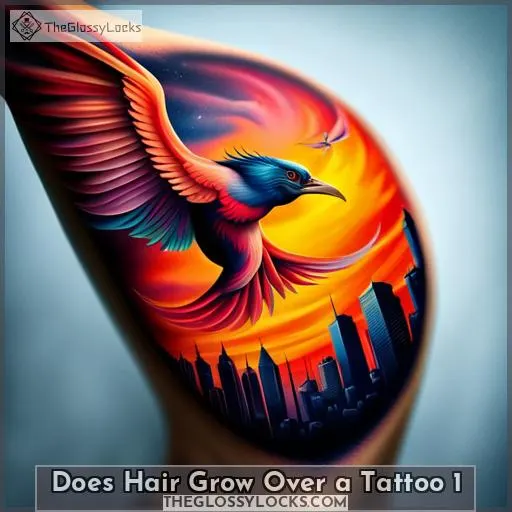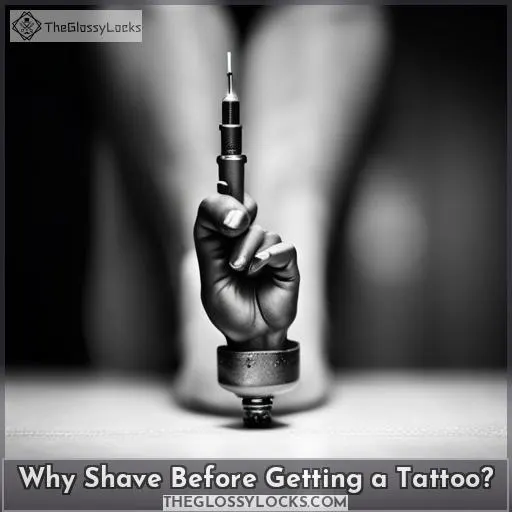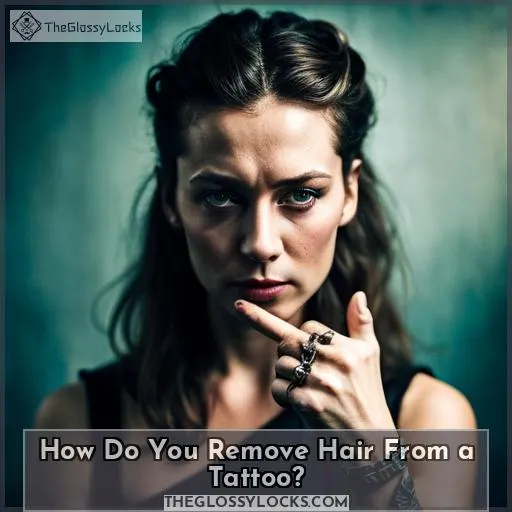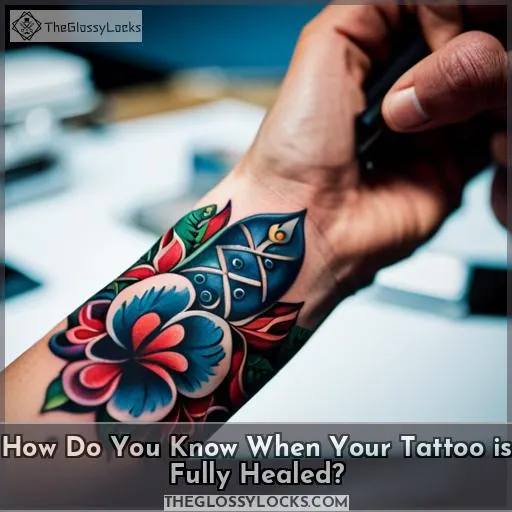This site is supported by our readers. We may earn a commission, at no cost to you, if you purchase through links.
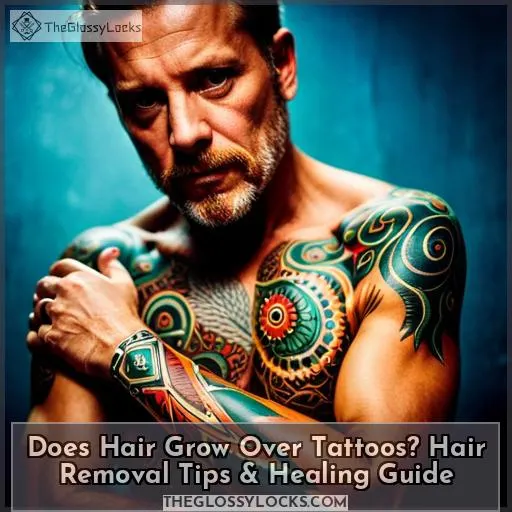 Ready for a radical new look? Tattoos are an incredible way to transform your appearance and express yourself. But before you jump in with both feet, it’s important to consider how hair growth might affect your design.
Ready for a radical new look? Tattoos are an incredible way to transform your appearance and express yourself. But before you jump in with both feet, it’s important to consider how hair growth might affect your design.
From shaving guidelines through healing tips, this article is here to answer all of these questions – and more! Let’s cut right into whether hair can re-grow over a tattooed area by exploring why pre-shaving is such an essential part of the process.
Table Of Contents
Key Takeaways
- Hair growth can affect the design and appearance of a tattoo.
- Proper precautions should be taken before getting a tattoo, including shaving the area for stencil adherence and reducing the risk of ingrown hairs.
- Laser hair removal should be avoided on tattooed areas, as it can potentially damage the ink.
- During the healing process, waxing and shaving should be avoided to prevent irritation and ensure proper healing of the tattoo.
Will Hair Grow Back Over a Tattoo?
After the procedure, it’s important to keep the area clean and moisturized so that your skin heals properly. Otherwise, you could end up with ingrown hairs or other issues that can affect how well your tattoo looks.
Caring for tattoos is essential for optimal ink care. Hair removal techniques such as waxing and shaving should be avoided during the healing process due to the risk of infection.
However, aftercare tips such as keeping an open wound moist with lotion will reduce the itching sensation caused by hair follicles regrowing around the tattooed area once healed. While there is no guarantee that hair won’t grow back over a tattoo in some cases, especially if proper precautions were not taken before getting inked, laser treatments are available to remove any unwanted growth without affecting the underlying dermis layer of your skin.
This is where the color resides permanently inside tiny cells called macrophages.
Why Shave Before Getting a Tattoo?
Shaving the area before getting a tattoo helps ensure that the artist’s stencil sticks properly and reduces the chance of ingrown hairs developing afterwards.
Proper preparation allows for a smooth, safe experience with fewer risks involved. It’s also crucial in protecting your tattoos from damage or fading due to hair growth on top of them later down the line.
When shaving, use only clean, sharp razors and shave against the direction of hair growth. This will help prevent razor burns and minimize irritation during your procedure, as well as aftercare application such as moisturizing creams or lotions.
Incorrectly done aftercare can sometimes block pores, leading to skin infections.
Laser hair removal should be avoided when having tattoos since this may affect how well ink stays intact over time.
Take proper care when shaving body or facial hair prior to any kind of tattoo procedure.
How Do You Remove Hair From a Tattoo?
Removing hair from a tattoo can be tricky, and there are several methods to consider. Electrolysis is the only permanent solution that won’t harm the ink of your design; however, tweezing or shaving with clean, sharp razors can also help keep it looking crisp.
Waxing may provide better results than other techniques, although it’s more painful and time-consuming. Alternatively, depilatory creams give an easier application but may be too harsh for sensitive skin.
Electrolysis
Electrolysis is the only permanent hair removal method that won’t interfere with your tattoo.
During electrolysis, small beams of electricity are used to target individual hair follicles and destroy them without affecting the surrounding skin or other hairs in the area. This precise approach can help prevent any damage done to your tattoo as well as provide longer-lasting results than shaving or waxing alone.
Be sure to follow all safety procedures when undergoing electrolysis, including proper skin preparation beforehand and aftercare procedures afterward, such as avoiding direct sunlight exposure on treated areas while they heal.
Laser alternatives may also be considered, but they should not replace professional advice from an experienced dermatologist when seeking long-term solutions for unwanted body hair growth cycles near tattoos!
Tweezing
For a precise and more lasting solution, tweezing is an option to consider for small tattoos in visible areas. It’s one of the slowest hair removal techniques available but provides excellent control over existing hairs.
Pre-tweezing skin care includes cleaning and moisturizing the area to reduce the pain level during plucking, as well as avoiding depilatory creams or waxes that may damage sensitive skin around ink lines.
Post-tweezing, immediately apply antiseptic cream on redness, then apply sunscreen when outdoors. This helps prevent ingrown hairs, which can damage the tattoo process if punctured with tweezers or other objects.
Although it may cause some temporary hair loss, regular trimming will help keep your design looking bright and crisp without any further complications!
Shaving
Before getting inked, you should use a clean and sharp razor to shave the area in the same direction as your hair growth for the best results. Preparing the skin is important before beginning any body art procedure, especially when lots of hair needs to be removed.
Shaving against the grain can cause irritation, razor cuts, and burns, which may also affect the healing process after tattooing. Laser removal is not recommended due to the risk of damaging surrounding ink lines.
Keeping the design looking bright and crisp requires regular trimming, but this won’t provide a permanent solution like electrolysis does.
Waxing
Waxing can be a real pain, but it’s worth the effort for smooth and lasting results.
- Drink lots of fluids to stay hydrated.
- Moisturize regularly in the area of your body that will be waxed.
- Avoid applying any oils or creams around the tattoo site – this could interfere with successful ink transfer!
- Consider using an exfoliating scrub beforehand to remove dead skin cells and open up pores. This will prevent ingrown hairs from forming after hair removal.
- Use numbing cream if you need extra relief from one of the most painful hair removal techniques out there!
By following these steps carefully, you’ll have no problems prepping your skin for a stunning tattoo design without risking damage to existing artwork.
Depilatory Creams
Depilatory creams offer an easy solution for getting rid of unwanted body hair without any pain, making them a great choice if you’re looking to tidy up your tattoo area. With little time and effort, depilatories can help provide a clear view of your skin with perfect stencil positioning for the location of the tattoo.
Avoiding shaving risks like ingrown hairs or razor burn is ideal when prepping for tattoos! Laser removal is not recommended due to potential damage caused to existing artwork, but regular skincare practices should be taken into consideration in terms of hair removal before committing to permanent ink designs on your body.
Hair growth cycles are unaffected by tattoos, so make sure you take all precautions before embarking on this journey!
How Do You Know When Your Tattoo is Fully Healed?
Once you’ve completed the tattoo healing process, you’ll know it’s time to celebrate when your skin is smooth and shiny! On average, tattoos take 4-6 weeks to heal completely, so make sure not to rush the process.
To ensure a successful result, there are several steps that should be taken during this period of aftercare. First, prevent ingrowns by shaving with foam or gel in the direction of hair growth. If infections arise, treat them swiftly. Additionally, moisturize your skin to keep it hydrated and avoid cuts from dryness.
The best way forward is finding what works best for you and understanding how delicate areas may require special attention. Many people opt for shaving because it’s fast and easy, but be careful as even sharp razors can cause painful cuts on already sensitive tattooed skin.
Waxing provides better results, but it also causes more pain, so consider alternative methods like tweezing small tattoos placed in an easily visible area or using depilatory creams. Although depilatory creams can be harsh on sensitive skin, they still provide an easier application than other techniques available.
Frequently Asked Questions (FAQs)
Are tattoos permanent?
Tired of the same old results? Look no further! Tattoos are permanent – a liberating way to express yourself and take control.
Can I get a tattoo if I have sensitive skin?
If you have sensitive skin, getting a tattoo may be difficult. However, with proper preparation and aftercare, it can still be done safely. Cleanse the area beforehand and shave with sharp razors in the same direction of hair growth to avoid issues like razor burn or ingrown hairs.
Does getting a tattoo hurt?
Getting a tattoo can be painful, but the level of discomfort varies depending on its location and the depth of the needle. A skilled artist will work quickly to minimize any distress. The use of topical anesthetics or numbing creams may also help reduce pain.
Is there a risk of infection when getting a tattoo?
Getting a tattoo is similar to playing Russian roulette; infection can occur if the artist’s tools and workspace are not sterile. To minimize your risk, make sure to verify their credentials and ensure they adhere to proper safety protocols.
How often should I moisturize my tattoo?
Moisturize your tattoo regularly to keep it looking vibrant and healthy. Apply a thin layer of lotion or ointment twice daily, avoiding scented products that may irritate the skin.
Conclusion
At the end of the day, the decision of whether or not to shave before getting a tattoo is ultimately up to you. Just be sure to use clean, sharp razors and shave against the hair growth direction for the best results.
After the tattoo is finished, the area needs to be kept clean and moisturized. Once you’ve seen the skin become smooth and shiny, you’ll know your tattoo has fully healed. So, don’t be afraid to take the plunge and get that tattoo of your dreams – just be sure to take the necessary steps to ensure it looks amazing.
After all, life is too short for bad tattoos – so get it right the first time!

